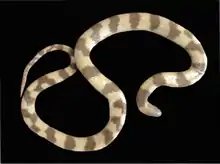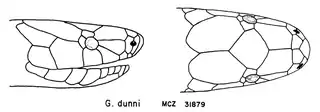Geophis dunni
Geophis dunni is a enigmatic snake of the colubrid family. It is presumably endemic to Nicaragua and is only known from a single specimen discovered in 1932.[2][3] This specimen was discovered by Karl Patterson Schmidt in the stomach of a Central American coral snake and has not been seen since.[2][4] It had a SVL length of 310 mm with a 57 mm long tail to get a total length of 367 mm (14.5 inches).[2][4][5] It is part of the Geophis sieboldi species group according to Floyd Leslie Downs.[6][5][7] This species was named by Schmidt after fellow herpetologist Emmett Reid Dunn "in allusion to his important contributions to our knowledge of this group of snakes".[2]
| Geophis dunni | |
|---|---|
 | |
| The only known specimen of Geophis dunni | |
| Scientific classification | |
| Kingdom: | Animalia |
| Phylum: | Chordata |
| Class: | Reptilia |
| Order: | Squamata |
| Suborder: | Serpentes |
| Family: | Colubridae |
| Genus: | Geophis |
| Species: | G. dunni |
| Binomial name | |
| Geophis dunni Schmidt, 1932 | |
This species is little known for several reasons. Geophis snakes are fossorial and nocturnal, and such are rarely observed in their natural habitat even by those actively searching for them. The snakes of this genus also form extensive species complexes where the only way to tell them apart is by slight differences.[7] For example, Geophis dunni differs from other species by having 17 dorsal scale rows along its body, 8 infralabial scales, and 140 ventral scales.[4] Additionally, the type locality given by Schmidt is very vague, only being "Matagalpa, Nicaragua". Matagalpa is both a city and a muncipality, and no data for elevation or habit type was specified either. However, Downs would mark a location in north Nicaragua at an elevation of 705 m as being the type locality of this snake,[6][5] but this location is exactly the city of Matagalpa and has been questioned by other papers on its accuracy.[4] For now, Geophis dunni remains data deficient until another individual is collected and a habitat is identified.

References
- Wilson, L.D.; Townsend, J.H.; Luque, I.; Stafford, P. (2013). "Geophis dunni". IUCN Red List of Threatened Species. 2013: e.T176807A1448010. doi:10.2305/IUCN.UK.2013-2.RLTS.T176807A1448010.en. Retrieved 18 November 2021.
- Schmidt, Karl (12 April 1932). "Stomach Contents of Some American Coral Snakes, with the Description of a New Species of Geophis". American Society of Ichthyologists and Herpetologists. 1932 (1): 6–9. doi:10.2307/1437020. JSTOR 1437020 – via JSTOR.
- Geophis dunni at the Reptarium.cz Reptile Database. Accessed 22 December 2018.
- Townsend, Josiah H. (2006). "Geophis dunni" (PDF). Catalogue of American Amphibians and Reptiles (CAAR) – via Texas ScholarWorks.
- Savage; et al. (20 August 2007). "Not so rare snakes: a revision of the Geophis sieboldi group (Colubridae: Dipsadinae) in lower Central America and Colombia". Zoological Journal of the Linnean Society. 153 (3): 561–599. CiteSeerX 10.1.1.865.1053. doi:10.1111/j.1096-3642.2008.00400.x – via CiteSeerX.
- Downs, Floyd (26 July 1967). "Intrageneric Relationships Among Colubrid Snakes of the Genus Geophis Wagler" (PDF). Museum of Zoology, University of Michigan. 131 – via University of Michigan Library.
- Wilson; et al. (January 2007). "A checklist and key to the snakes of the genus Geophis (Squamata: Colubridae: Dipsadinae), with commentary on distribution and conservation". Zootaxa. 1395 (1): 1–31. doi:10.11646/zootaxa.1395.1.1 – via ResearchGate.
